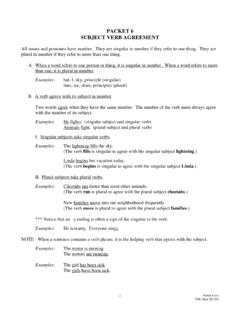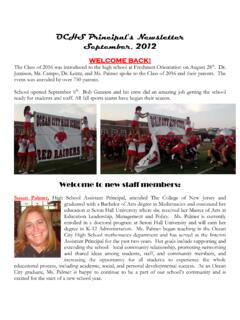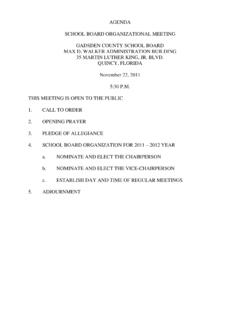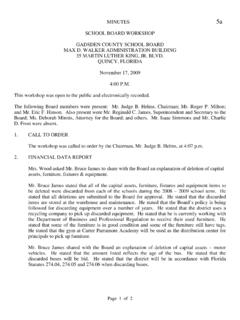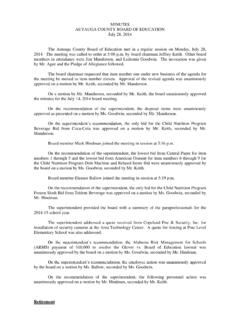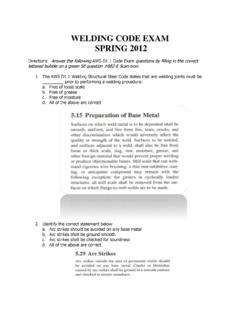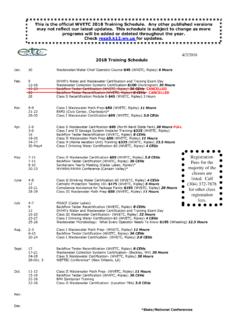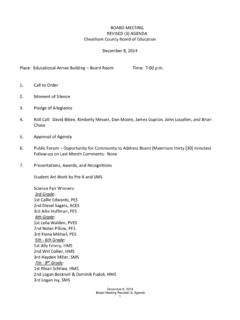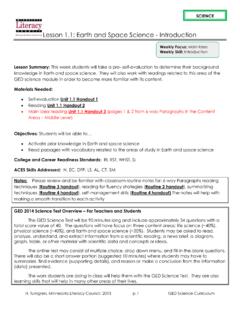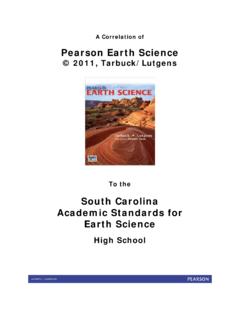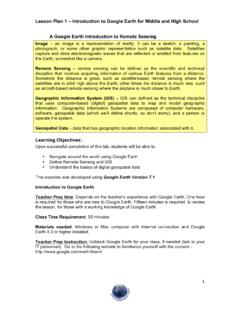Transcription of 01 SW6 LP - PC\|MAC
1 earth ScienceDirected ReadingHOLTC opyright by Holt, Rinehart and Winston. All rights earth Science 7 introduction to earth ScienceName Class DateSkills Worksheet Directed ReadingSection: What Is earth Science? 1. For thousands of years, people have looked at the world and wondered what shaped it. 2. How did cultures throughout history attempt to explain events such as vol-cano eruptions, earthquakes, and eclipses? 3. How does modern science attempt to understand earth and its changing landscape? THE SCIENTIFIC STUDY OF EARTH_____ 4. Scientists in China began keeping records of earthquakes as early as a.
2 200 BCE. b. 480 BCE. c. 780 BCE. d. 1780 5. What kind of catalog did the ancient Greeks compile? a. a catalog of rocks and minerals b. a catalog of stars in the universe c. a catalog of gods and goddesses d. a catalog of fashion_____ 6. What did the Maya track in ancient times? a. the tides b. the movement of people and animals c. changes in rocks and minerals d. the movements of the sun, moon, and planets _____ 7. Based on their observations, the Maya created a. jewelry. b. calendars. c. books. d. by Holt, Rinehart and Winston. All rights earth Science 8 introduction to earth ScienceName Class DateDirected Reading continued_____ 8.
3 For a long time, scientific discoveries were limited to a. observations of phenomena that could be made with the help of scientific instruments. b. observations of phenomena that could not be seen, only imagined. c. myths and legends surrounding phenomena. d. observations of phenomena that could be seen with the unaided 9. What inventions in the 17th century made seeing previously hidden worlds possible? a. the astrolabe and the compass b. the microscope and the telescope c. the microscope and the corrective lens d. binoculars and magnifiers _____ 10. earth science is the scientific study of a. astrology. b. supernatural phenomena. c. cosmetology. d. earth and the universe around it. _____ 11.
4 It is assumed in earth science that causes of natural events, or phenomena, a. can be understood through careful observation and experimentation. b. can be understood through methods other than careful observation and experimentation. c. will not be understood until the next century. d. can never be fully OF earth SCIENCE_____ 12. What improves when technology, such as new processes or equipment, is developed? a. the ability to change human nature b. the ability to make observations c. the ability to prevent wars d. the ability to prevent natural disasters _____ 13. The four major areas of study in earth science are a. volcanology, astronomy, geology, and meteorology. b. the solid earth , the oceans, the atmosphere, and the universe beyond earth .
5 C. the earth around us, the earth we can see, the earth we cannot see, and the universe. d. geography, agriculture, astronomy, and by Holt, Rinehart and Winston. All rights earth Science 9 introduction to earth ScienceName Class DateDirected Reading continued_____ 14. Geology is the scientific study of a. rocks, maps, processes, and technology of earth . b. legends, observations, technology, and structure of the solid earth . c. the origin and history of Mayan culture. d. the origin, history, structure of earth , and the processes that shape 15. Areas of study for geologists might include a.
6 The atmosphere, climate, and weather patterns. b. earth s crust, forces within earth , and fossils. c. chemistry, physics, and math. d. diet, nutrition, and exercise. 16. What is the scientific study of the oceans called? 17. Name four features of the ocean that oceanographers study. 18. A branch of science called is the scientific study of earth s atmosphere, especially in relation to weather and climate. 19. Name two technologies that meteorologists use to study the atmospheric con-ditions that produce weather. 20. Name three weather factors that meteorologists measure. 21. Define climate. Copyright by Holt, Rinehart and Winston. All rights earth Science 10 introduction to earth ScienceName Class DateDirected Reading continued 22.
7 The scientific study of the universe, called , is one of the oldest branches of earth science. 23. How long ago were the ancient Babylonians charting positions of the planets and stars? 24. Modern astronomers use earth - and space-based to study the sun, the moon, the planets, and the universe. 25. What two technologies have provided astronomers with new information about the universe? 26. A new field of earth science called studies the ways in which humans interact with their environment. 27. Name four issues that environmental scientists study. THE IMPORTANCE OF earth SCIENCE_____ 28. Natural forces that shape earth a. have little or no effect on life on earth . b. affect life on earth . c. have not been studied.
8 D. are hard to quantify so they cannot be 29. What natural event could bury a town under ash? a. lunar eclipse b. earthquake c. volcano d. flood_____ 30. What natural event could produce waves that destroy shorelines? a. earthquake b. forest fire c. volcano d. lunar eclipseCopyright by Holt, Rinehart and Winston. All rights earth Science 11 introduction to earth ScienceName Class DateDirected Reading continued_____ 31. By understanding how natural forces shape our environment, earth scientists can a. design devices to prevent natural disasters. b. figure out how to increase workforce productivity.
9 C. teach people how to lead healthier lives. d. predict potential disasters more accurately and help save lives and property. _____ 32. The work of earth scientists can help us understand our place in a. the universe. b. the atmosphere. c. the food chain. d. our 33. Which category of earth scientists has come up with new ideas about the origins of our universe? a. meteorologists b. cosmetologists c. astronomers d. astrologists_____ 34. The resources that make life as we know it possible come from a. earth . b. other galaxies. c. hard work. d. the 35. earth scientists strive to help people learn how to a. improve their diets. b. invest their money. c. read and write. d. use earth s resources by Holt, Rinehart and Winston.
10 All rights earth Science 12 introduction to earth ScienceName Class DateSkills Worksheet Directed ReadingSection: Science as a Process 1. How does science differ from other kinds of human endeavors such as art, architecture, and philosophy? 2. What is the goal of science? 3. What do scientists do? BEHAVIOR OF NATURAL SYSTEMS_____ 4. Scientists begin with the assumption that nature a. is undeniable. b. is understandable. c. is nearly impossible to understand. d. cannot be 5. What do scientists expect? a. Different forces in different situations will cause similar results.
